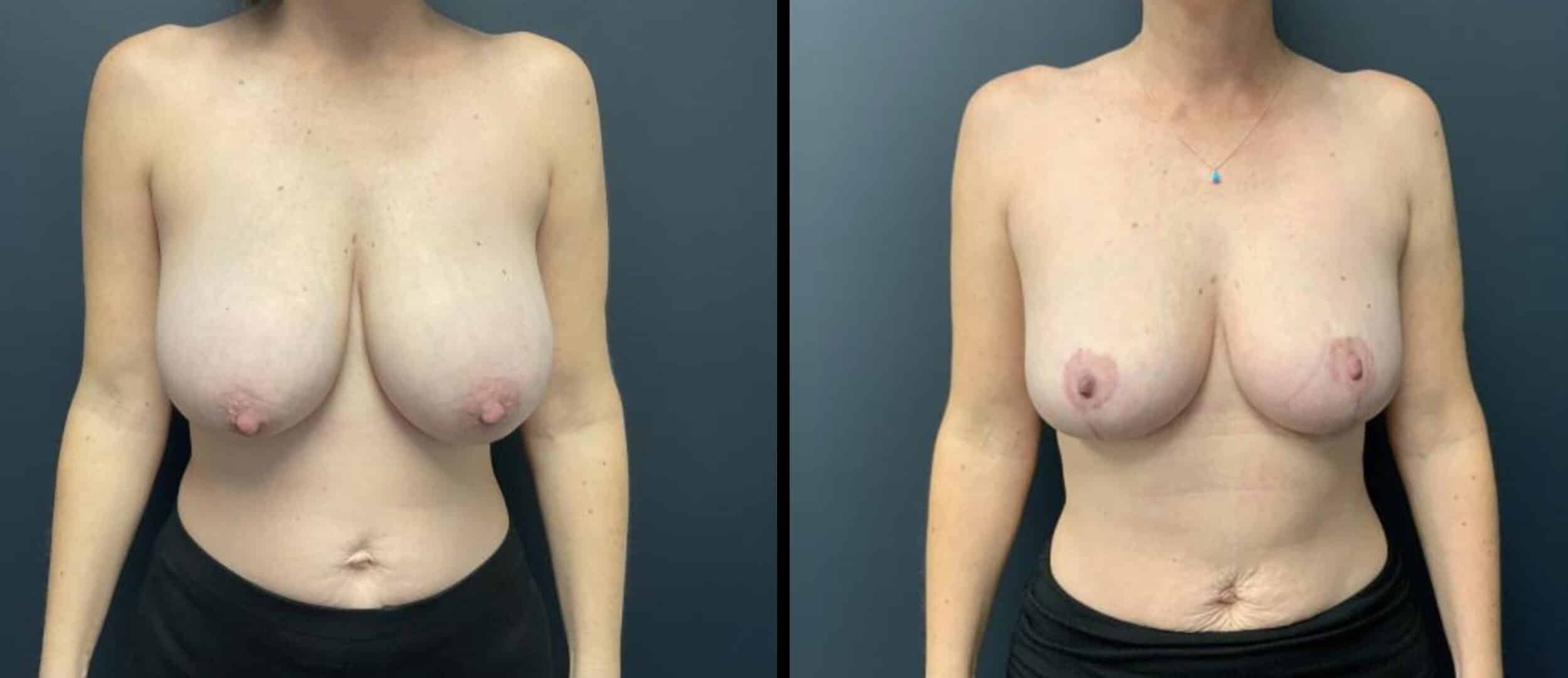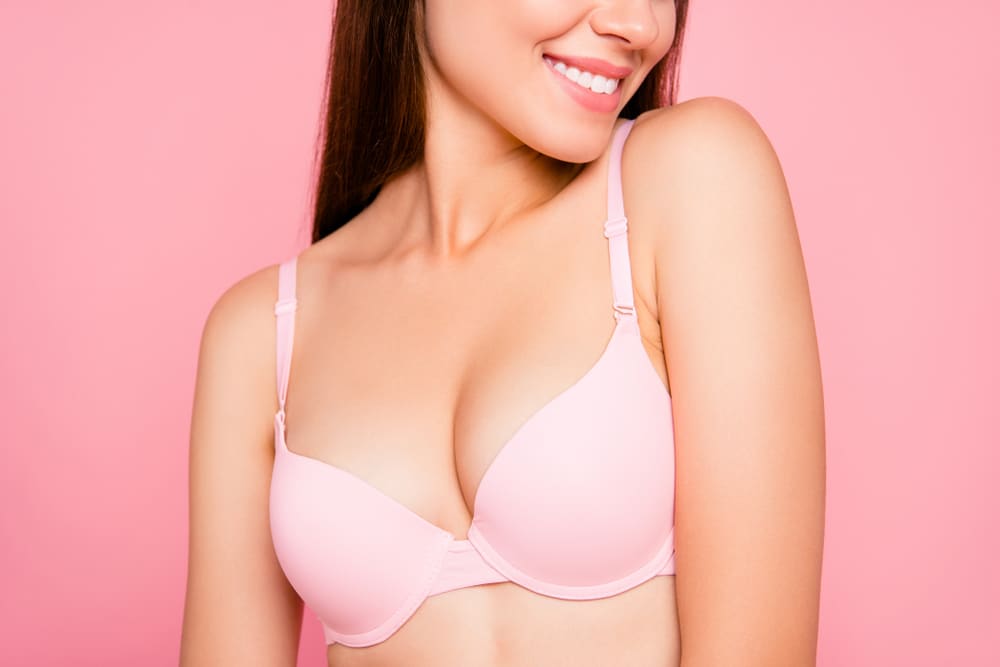Board-Certified Plastic Surgeons Serving Denver & Lone Tree, Colorado
Many women have large and pendulous breasts that may adversely affect their sense of beauty and femininity. Not only can overly large breasts cause psychological symptoms and make women self-conscious and uncomfortable with their body-image, but heavy breasts can cause physical symptoms as well. Back and neck pain, painful grooves on the shoulders from bra straps, and even tingling fingers can all occur from excess breast weight on the chest. Some women with large, pendulous breasts have rashes, yeast infections, and non-healing skin wounds where their breasts rub on their chest or abdomen. The constant moisture and rubbing of the bra against this area can be very troublesome, especially in the hotter summer months.

Cosmetic breast reduction surgery is a highly successful procedure that removes fat, glandular tissue and skin from the breast to alleviate the physical symptoms of pain and skin irritation. However, the surgeons at Park Meadows Cosmetic Surgery also endeavor to restore a woman's sense of femininity and natural beauty by restoring the breasts to a more elevated, youthful, and aesthetically pleasing shape that is balanced with the patient's body.
Thus, a truly successful cosmetic breast reduction not only reduces the size of the large breasts, but also lifts them to a higher position, reduces the size of large areola (the circular colored part of the nipple), and provides a more youthful feminine and balanced shape.
View images of our Cosmetic Breast Reduction Surgery patients in our Before & After Gallery.

Is Cosmetic Breast Reduction Right for Me?
If you are a woman with large, pendulous breasts, who suffers from the physical and emotional symptoms described above, then you are a candidate to be evaluated for a breast reduction. However, every woman is different, and your surgeon at Park Meadows Cosmetic Surgery will examine your breasts and review your general medical history to help determine if you are a good candidate for surgery.
Usually surgery is an option once the breasts have fully matured (after puberty); however, there are rare cases where extremely large breasts in young women can be reduced before full maturity. The best surgical candidates are those women who are also mature enough to understand the procedure and have realistic expectations about the results. Women who have a strong desire to breast feed after surgery are strongly cautioned that any breast surgery has a risk of altering her ability to breast feed successfully.
Preparing for Your Cosmetic Breast Reduction Surgery
The surgeons at Park Meadows Cosmetic Surgery may recommend that you have a current mammogram (breast X-ray) before your surgery, especially if you are older than 40. Any breast surgery can alter your mammogram, so it is helpful to have a preoperative X-ray on record to compare if questions arise. You will also get a set of pre-operative instructions describing how you should prepare for surgery.
Certain medications and nutritional supplements can thin the blood and need to be stopped two weeks prior to surgery. The need for a blood transfusion because of breast reduction surgery is extremely unusual, but is slightly more common in patients with very large breasts.

Read what our patients are saying!
"I’m extremely pleased with the services I received at Park Meadows Aesthetics. Everyone was professional and friendly from my initial contact with Jennifer, making my appointment and checking in when I arrived, as well as Krista, who did my Botox. I have worked in Plastic Surgery, as an RN, for many years and just moved to the area. I was concerned that I find quality care. I am familiar with the skill and expertise it takes to provide excellent care and I definitely received it at Park Meadows Aesthetics. I will absolutely return! Thank you Jennifer and Krista!"
Cosmetic Breast Reduction Surgery
There are several techniques for cosmetic breast reduction; however, all of them address the excess breast gland, the excess breast skin, and the abnormally low nipple position. Your surgeon will discuss which technique is best for you. The most common technique for very large breasts will leave a scar around your nipple, straight down the breast below the nipple, and under the breast hidden in the breast fold.

Some women are good candidates for “limited scar” or “short scar” techniques that can eliminate either the scar in the fold of the breast or the vertical scar from the areola down to the breast fold (inframammary fold).
Scars resulting from breast reduction can be treated and reduced with scar therapy adhesive sheets. These silicone sheets relieve skin tension, which is the root cause of pronounced scarring. They also soothe and hydrate the scar with silicone gel.
Liposuction may be used to remove excess fat from the armpit area or in very select cases to perform the procedure.
Stitches are usually buried and dissolve. The patient will usually never see them or have the unpleasant experience of having multiple sutures removed in the office.
All Surgery Carries Some Uncertainty & Risk

Reduction mammaplasty is not a simple operation because the surgeon has to remove excess fat, glandular tissue, and skin and recreate a lifted, aesthetically pleasing breast in a patient who may never have had smaller, more elevated breasts. However, the operation is normally safe when performed by a qualified surgeon.
Nevertheless, as with any surgery, there is always a risk of complications. These include excess bleeding, infection, poor skin healing, poor breast healing. Because it is necessary to make incisions around the areola and nipple to move them to a higher location, the nipple can be at risk. In very rare circumstances, the skin of the nipple can loose its blood supply. If this happens, the nipple can die and cause permanent scarring. This can be corrected to a large extent after healing by rebuilding the nipple (as is done for patients with breast cancer), but permanent scars of the nipple itself are still a rare risk of breast reduction, especially very large procedures.
Smokers are at higher risk for many of these complications. It is important to stop smoking at least a month before surgery.
Delayed Wound Healing and Dehiscence: In some instances, the incision site takes longer to heal than normal. Cigarette smoking, poor nutritional status and a compromised immune system can all cause delayed wound healing or wound separation.
Scars: A surgeon cannot lift and reshape the breast without making incisions except in very select patients who may have their breasts reduced by liposuction alone. Any incision will produce a permanent scar. Your surgeon will discuss with you one of several options depending on your breast shape and size. However, most scars heal well and almost all patients are happy to trade these incisions for a life free of back and neck pain and an improved sense of femininity and self-confidence. In the rare incidence, a scar will be thick and unattractive. If this is the case with your scars, your surgeon will provide several options to fix or improve them. Regardless, your scars should all be hidden behind a bathing suit top or a bra.
Asymmetry: There is a saying, “Breasts are sisters, not twins.” That is to say that every woman has some natural asymmetry in their breasts. Your surgeon will endeavor to correct any natural differences in your breasts and make your breasts match in size and shape. However, in any type of breast surgery, there can be slight differences in nipple position, breast shape, fullness, and healing that are impossible to predict. If large differences occur after surgery, your surgeon is committed to provide you with the most pleasing result he thinks he can provide.
Breast Sensation: Breast and nipple sensation can be changed by any breast surgery and especially breast reduction surgery. These changes are usually temporary, but can be permanent and may affect your sexual response or your ability to nurse a baby. Many women will have no change in their sensation.
Breast Feeding: A women’s ability to breast feed can be permanently affected with any breast surgery. It is important to remember about 10% of normal women can not breast feed even without surgery. Having a Breast Reduction will increase this risk. Often women will be able to breast feed but will have to supplement with a bottle because their milk supply will not be adequate In rare cases for extremely large reductions, the nipple will have to be removed and replaced as a “free nipple graft” which will totally disconnect the milk ducts from the nipple. These patients will not be able to breast feed at all.
Pain: If you experience severe pain not relieved by pain medicine notify your surgeon immediately. Some discomfort is expected after surgery and you will receive a prescription for pain medication. The intensity and duration of pain after breast reduction will vary among women. Prolonged or intense pain can be due to scarring around a nerve.
Infection: A small number of women develop an infection. This typically can occur several days to several weeks after the procedure. If an infection does not respond to oral antibiotics, a patient may need intravenous antibiotics in the hospital. Hospitalization is very rare.
Hematoma and Seroma: A hematoma is a collection of blood under the skin, and a seroma is a collection of the watery portion of the blood under the skin. Hematomas or seromas typically develop within the first few days after surgery; however, they may occur at any time after injury to the breast. The body can reabsorb small hematomas or seromas. Larger ones require the placement of surgical drains for proper healing. A small scar can develop at the surgical drain site.
Delayed wound healing and dehiscence: In some instances, the incision site takes longer to heal than normal. Cigarette smoking, poor nutritional status and a compromised immune system can all cause delayed wound healing or wound separation.
After Your Cosmetic Breast Reduction
You will be given a comprehensive set of post-operative instructions prior to your breast reduction surgery. You will have steri-strips covering your incisions. Some patients will have tape or bandages covering the breasts to help shape or support the breast after surgery. You will be given a post-surgical bra to wear for approximately 6 weeks. Many women find they can alternate this with a non-underwire supportive exercise bra after 2 weeks.

Some patients will need drains in the breast for a short time. If you have drains, you and your family will be instructed on how to care for them. Most women are able to return to work 10 to 14 days after surgery if they do not have a very active job that requires heavy physical lifting or activity. It can take up to 6 months for the breasts to “settle” and achieve their final shape.
Patients can experience random, shooting, discomforts or pain after surgery. This is normal and typically improves within several months. Some women will notice changes in their breast and nipple sensation after surgery. Some women are more sensitive, while others are less sensitive. These sensations tend to even out over time, but in a few cases can be permanent.
Additional Surgeries
In the vast majority of cases, your breasts can be reshaped in 1 surgery. However, in some women, healing can be unpredictable resulting in significant differences in breast shape, symmetry, or nipple position. In some cases a second smaller “touch up” surgery is required to give you the best result possible.
Why Choose Park Meadows Cosmetic Surgery
At Park Meadows Cosmetic Surgery, we’re proud to be a trusted leader in breast reduction surgery and other transformative procedures. Our practice is led by two board-certified plastic surgeons, Dr. Christopher Williams and Dr. Jeremy Williams, who bring a wealth of expertise and a dedication to patient safety. Certified by the American Board of Plastic Surgery, they’ve demonstrated exceptional skill, rigorous training, and a commitment to providing superior care. From your initial consultation to your recovery, our team wants to exceed your expectations and deliver results that elevate your confidence and quality of life.
Our state-of-the-art facilities are made with comfort and safety in mind. As the first state-licensed, Joint Commission-accredited surgical center in Douglas County, our surgery center offers two fully-equipped operating rooms, private recovery suites, and a welcoming environment to support your journey. Conveniently located in South Denver near Park Meadows Mall, our practice provides a seamless experience for patients seeking world-class care.
Frequently Asked Questions
Breast reduction surgery can enhance your life by alleviating physical discomfort like back, neck, and shoulder pain often caused by large breasts. It can also help reduce skin irritation, improve posture, and make physical activities easier and more enjoyable. Additionally, the procedure can boost your self-confidence and provide a more proportionate body contour.
The size of your breasts depends on your goals, body proportions, and the amount of tissue to be removed for your ideal outcome. During your consultation, your surgeon will work with you to establish the most suitable size based on your preferences and anatomy.
Yes, breast reduction surgery is often done along with a breast lift for the best outcome. A lift reshapes and repositions the breasts, ensuring they are firmer and more youthful-looking after reduction. Many patients choose this combination for both functional and aesthetic benefits.
Breastfeeding after a breast reduction may still be possible, but it depends on the surgical technique used and the amount of tissue removed. Some techniques preserve the milk ducts and glands, increasing your chances of breastfeeding. Discuss breastfeeding with your surgeon during the consultation if breastfeeding is a priority.
Breast reduction surgery provides long-lasting results, but it is not entirely permanent. Factors such as aging, hormonal changes, pregnancy, and significant weight fluctuations can impact the size and shape of your breasts over time.
Weight changes can alter the results of your breast reduction. Significant weight gain can cause breast size to increase again, while substantial weight loss could lead to sagging or changes in breast shape. Maintaining a stable weight is best to preserve your results.
There is no specific age limit for breast reduction surgery. However, the procedure is typically recommended for individuals whose breasts have fully developed. A surgeon may recommend waiting until growth is complete in younger patients to ensure stable results.
Schedule Your Cosmetic Breast Reduction Consult Today!
To learn more about cosmetic breast reduction, contact our board certified plastic surgeons at Park Meadows Cosmetic Surgery in Lone Tree serving Denver and all of Colorado. Schedule a free cosmetic consultation by calling us at 303-706-1100 or by filling out the Appointment Request Form below. Our top doctors look forward to serving you!
